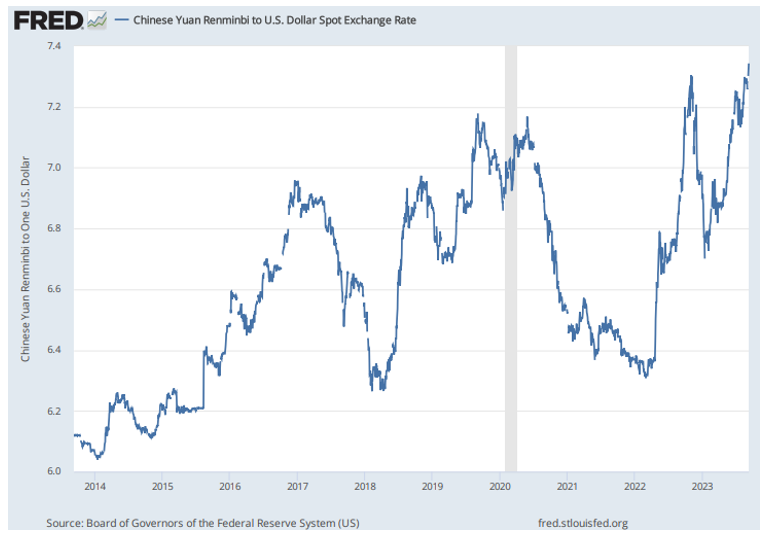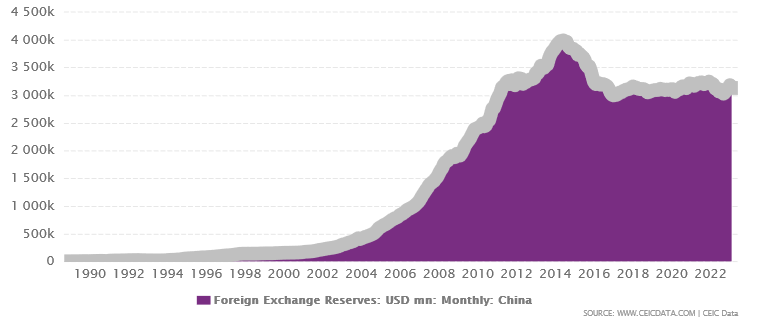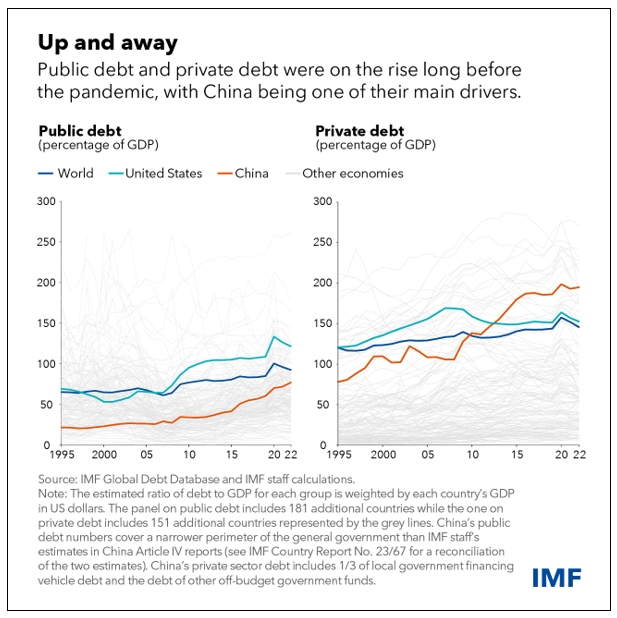China’s macro-financial model appears to be in difficulty. The recent depreciation of the yuan, most notably against the US Dollar, reflects increasing concern over the integrity of the Chinese credit system. For years, Chinese entities have used cheap short-term US Dollar borrowing to extend their global reach, but the sudden normalisation of US and European interest rates has thrown a massive spanner in the works. China appears to be using its still-impressive international trade and portfolio capital account surplus to mitigate the painful debt service costs of Chinese business entities and to assist in the repayment of foreign currency debts. However, these repayments are enabling foreign banks to shrink their balance sheets and improve their capital positions. China is fuelling a global credit crunch that threatens to suck the life out of the global economy.
China is torn between two worlds: the one it can control and the one it can merely influence. Within its domestic economic and financial system, it can inflict poor returns and painful losses with impunity. But in the wider world, China must present itself as a reliable ally, an attractive trading partner and an alluring investment destination. The portrayal of national financial strength is vital to its ambitions, not least the internationalisation of the yuan. Beijing longs for the day when a petro-yuan rivals the greenback’s status as the petro-dollar for commodities settlement, positioning China as the economic anchor to a potential Asian, Middle Eastern and BRICS trade bloc. Yet its penetration of the global payments system is stuck at 3 per cent (figure 1) after China suffered capital outflows in 2022, coinciding with the surge in overseas interest rates. To add insult to injury, the yuan has lost 15 per cent of its value against the US Dollar in the past 18 months (figure 2).
China’s closed capital account is designed to maintain a dichotomy between foreign and domestic opinions of China’s vast credit system. Its sizeable foreign exchange reserves (figure 3) are widely considered to confer investment grade status on Chinese sovereign credit. The presumption of implicit state backing for the Chinese banking and financial system imputes this strong credit rating to a large swathe of financial entities and large corporations. However, those foreign reserves peaked in terms of nominal US Dollars in 2014 and have stagnated since 2016 despite consistently large current account surpluses. When scaled by the balance sheet footings of the Chinese financial system, its foreign exchange reserves have shrunk significantly, for example, from 22 per cent of M2 in 2014 to 8 per cent in 2022. Does China have adequate reserves of hard, convertible currency to defend its domestic credit system and sustain its global ambitions?
The recent publication of the IMF’s Global Debt Database contains alarming evidence of China’s profligate use of debt in pursuit of growth (figure 4). The blurring of the categories of public and private debt suggests that we should take the combined figure as the more reliable. However, the meteoric rise of household debt to GDP from 10.6 per cent in 2006 to 61.5 per cent in 2022 shows just how important a role leverage has played in China’s recent development. This debt lies predominantly in safe hands, but the local government debt that has financed high-speed rail links and rapid urban development is another matter. In May, The Economist reported that Guizhou is believed to owe 130 per cent of its provincial GDP and that its annual interest payments comprise 56 per cent of annual revenues. Should China fall victim to a domestic financial crisis, it is conceivable that the losses to be absorbed by the state could exceed the reported US$3.2trn of official foreign exchange reserves.
For many years, China’s separated credit system was an asset to the global economy, imparting a countervailing force to the US-dominated western credit cycle and a stabilising force to the global financial system. We now observe a China that has been humbled by surging interest rates in the western world and is battling the same contractionary forces as the advanced economies of North America and Europe: a China that appears to be facilitating the retrenchment of western banks and financial institutions and reinforcing recessionary dynamics in the global economy.
Figure 1:

Figure 2:

Figure 3:

Figure 4:


